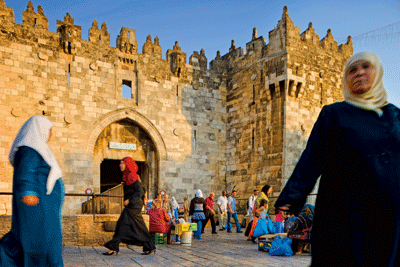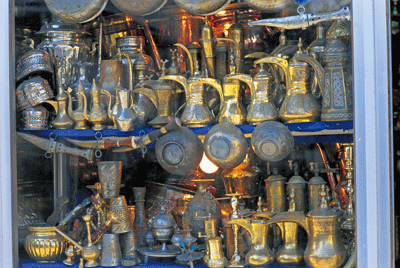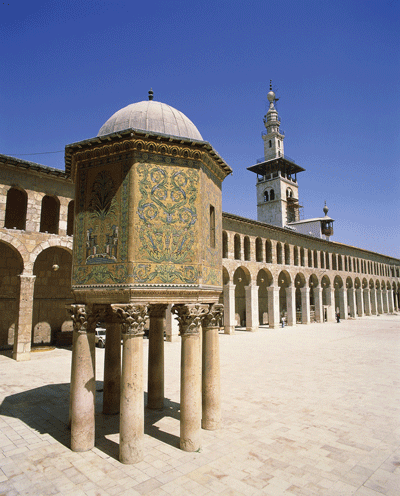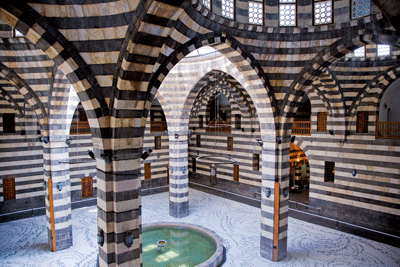Almost every city in the Levant declares it is the oldest continuously inhabited city in the world. But Damascus, with its wealth of venerable literary references and ancient archaeological finds, has among the most legitimate claims. The “Street Called Straight” (“Via Recta” in Latin) is mentioned in the Bible for being the setting of a miracle; as the Road to Damascus, it has become a metaphor for a radical change of heart, thanks to St Paul’s alleged conversion there. It’s still there and it’s still very straight.
There’s something stirring about wandering through all these ancient landmarks. And Syria isn’t just a record of biblical history – it’s a living museum.

Within easy reach of Damascus you’ll find stunning crusader castles – relics of the religious campaigns to colonise the Middle East that began more than 900 years ago – Roman ruins, and ancient villages and landscapes. Sednaya, also just a day trip away, is a bleached rock fortress founded by a Byzantine emperor with an old Greek Orthodox convent at its heart. Palmyra is an ancient Roman city and a well-preserved example of the wealth that the caravan trade routes brought to the region. Maaloula, a tiny village nestled in the mountains, is also reachable on a day trip, and is one of the few places in the world where Aramaic, the language of Jesus, is still spoken. Hama, to the North, boasts early waterwheels and aqueducts for irrigating the surrounding farmland that are unique to the region and thought to date back 8,000 years.

That’s not even to touch on what lies within the city walls. Here, you’ll find a heady, living mix of ancient and modern Islamic, Roman, Christian, Byzantine and Ottoman architecture. The Old City is still the focal point of daily commerce. The markets here are as full of locals picking up their groceries as they are of tourists snapping photographs. Visitors will probably be most drawn to the Souk al Hamidiyeh, an arcaded shopping centre stuffed to bursting with tasty snacks, souvenirs and trinkets, although you’ll benefit just as much from wandering around the quieter side streets. For an authentic keepsake of your trip here, pick up some of the mother-of-pearl inlaid furniture for which the city is famous. Restricted to hand luggage? Instead of the ornate armoires, plump for an inlaid backgammon board (you’ll see locals playing this game at every available moment) or some traditional Damascene lace.
Wandering through the fort will lead you to the Umayyad Mosque, a striking example of Islamic architecture and open to tourists of all denominations outside prayer time. It houses the mausoleum of famous Muslim leader Saladin, whose finest hour came when he recaptured Jerusalem from the crusaders in 1187, refusing to allow his soldiers to kill or rob civilians in
the process.

Rather gruesomely, the same mosque is also home to a shrine said to hold the head of John the Baptist. Even if ancient history isn’t your thing, you’ll surely enjoy the graceful architecture, polished marble and welcoming faces in one of the region’s most impressive mosques.
Also near here is the striped Azem Palace, home to an Ottoman governor and his family from when it was built in 1750. It has two wings, making the divide between public and family life plain. The gentlemen conducted the troubling business of business in the grand salamlik area while the women and children enjoyed the tranquility of the haramlik, where gurgling fountains, private baths and servants’ quarters are found. Today, it also functions as a museum of life in a bygone age.
Speaking of baths, when you are tired of the heat and dust of the streets – and Damascus is particularly hot and dusty – pop into one of the countless hammams dotted around the city for a thorough steam and a salubrious scrub-down that will leave you feeling refreshed. Turkey and Syria know what they’re doing when it comes to baths.
Slightly away from the centre is the magnificent National Museum, a sprawling building that houses the very best of Syria’s antiquities. Though the presentation sometimes lacks finesse, the collection of archaeological finds is outstanding. The doorway is a transplanted gateway from a desert castle near Palmyra and inside the ancient items are divided into Arab Islamic, Classical, Byzantine, Phoenician and Ugarit sections, among others. A fully reassembled second-century synagogue is supposed to be the star attraction, but every bit as impressive is the tiny cuneiform stone showing the world’s first known alphabet.

But just as every city in this region wants to be crowned the longest standing, every country in the Levant has been blighted by some kind of war or political infighting. Damascus was once the banking capital of the Middle East and a honeypot for tourists, but as the region became unstable, its popularity waned and investment dwindled.
But times have changed. The country has been undergoing steady, extensive reform for a number of years under the auspices of President Bashar al-Assad. Economic, financial, banking, administrative and legislative frameworks have been reshaped towards a liberal market economy aimed at attracting investment and combining it with fair, sustainable development. Its key industries have traditionally been agriculture, oil and tourism.
Although growth slowed to 1.8 percent in 2009 (CIA figures) as a result of the economic downturn, officials are targeting a moderate 5 percent going forward. Of the 21 million population, 36 percent are under the age of 15 and the numbers are growing fast.
The government has been strengthening relations with France, one of its key export partners, and Jordan, in a bid to heal a long-standing rift. Trade agreements have been signed with Turkey and the country is being courted by China in pursuit of access to its gas fields, while at the same time it’s trying to position itself as a transit point for major oil and gas pipelines. Syria has achieved status as an observer with the World Trade Organization, a precursor to full membership, as a result of its commitment to market development and integration with the international community.
The Prime Minister, Naji al-Otari, points out that the country’s geographical location between three continents is an advantage in doing business, reducing transport costs while providing a rich menu of natural resources and trained manpower. The country’s authorities have recognised that a skilled, cheap workforce is a key resource in attracting investment; the only problem is that they’ve tried to ensure one by introducing new labour laws that some have argued are attractive to business at the expense of the average worker.
In fact, Syria hopes to attract US$55 billion of foreign direct investment over the next five years, compared with US$2.5 billion this year. Infrastructure in particular has been identified as an area ripe for promising public-private investment. There are plans to withdraw the overarching, overpowering role of the state in economic affairs – influences, sometimes corrupt, that are often perceived to mar the nation’s investment climate.
If business is starting to trickle in, then tourists are flocking in, many heading first for Damascus. It’s been the place to go this year. Visitors from the Gulf, Turkey and the Levant have been taking advantage of Syria’s relatively cheap prices, while tourists from Europe, especially France, Spain and the UK, have come in search of exotic escapades. Last year, tourist numbers increased by 12 percent; around 6.5 million tourists visit annually, a figure that the government wants to increase to 14 million by 2015.
More tourists have meant more and better facilities for them to enjoy. The Four Seasons Hotel is a shining example of the international-standard five-star hotels that are opening up. In the Old Town, large, rambling, traditional houses have been converted into bijou boutique hotels, restaurants and bars. Porsche has even opened a sales and service centre in the city, an indication of the city’s new-found wealth and status. There is plenty for leisure travellers to explore in the city, not even counting side trips to nearby attractions, while Syria’s improved position on the international stage should surely be enough to attract speculative business visits.
Perhaps one of the best spots in which to contemplate the city and its merits is atop Mount Qassioun. The 1,200m mountain is ringed with little bars and coffee shops, and is popular among locals and guests alike at sunset. From here, you can enjoy a drink, a snack and a refreshing breeze as you watch the light fade on Syria’s capital. Apparently, the Prophet Mohammed arrived here on his caravan trips across the region and, upon glimpsing the city, turned away from this “earthly paradise”, preferring to wait for the other-worldly version. I can’t vouch for paradise, but I can vouch for Damascus. And after my visit here, I can see what he meant.








